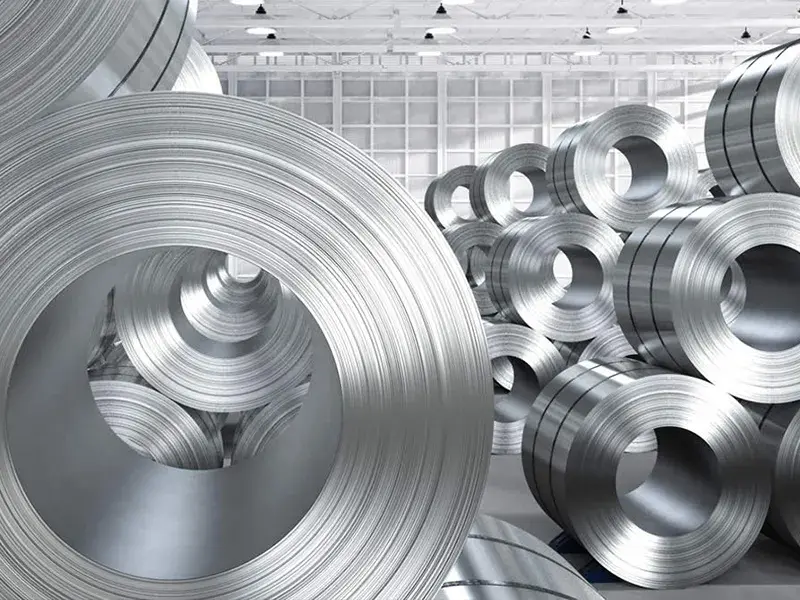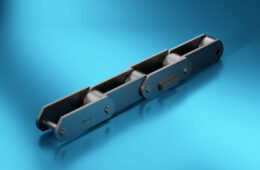 As Makelsan Chain, offer you special solutions in steel industry areas such as sintering plants, blast furnace applications, steel processing applications.
As Makelsan Chain, offer you special solutions in steel industry areas such as sintering plants, blast furnace applications, steel processing applications.
- sintering plants
- blast furnace applications
- steel processing applications
- ingot casting and continuous casting applications
- rolling mill applications
- transport and strip accumulator chains for treatment lines in hot and cold areas
Chains and Sprockets Needed by the Iron and Steel Industry
As Makelsan Chain, we produce high-strength chains and sprockets for the iron and steel industry. We design and engineer iron and steel chains with many different steps and connection types in line with the needs of the industry. We produce these chains, which can operate smoothly in very heavy conditions, extremely hot or dusty environments, from special alloy materials; We ensure that the chains show high performance and long life in all working conditions.
In Which Applications Are Chains and Sprockets Used in the Iron and Steel Industry?
For years, the iron and steel chains we produce within the scope of our experience and wide product portfolio are used in many different applications. We offer the chains and sprockets we design and manufacture for sintering plants, blast furnace applications, steel processing applications, ingot casting and continuous casting applications, rolling mill applications, transportation and strip accumulator chains for treatment lines in the hot and cold zone in the iron and steel industry.
Makelsan Chain Types for the Needs of Iron and Steel Industry
Iron and steel chains produced by Makelsan Chain include Rolling Mill Chains, Ingot Mold Carrier Chains, Transfer Line Chains, Cooling Line Chains. Gall Chain is another important product among iron and steel chains. The most important feature of Gall Chains, which are used as load chains for high forces at low speed, are more resistant to deformation and have a relatively higher breaking strength than roller chains. Gall chains, which we produce in line with the needs and demands of our customers, are frequently preferred in the iron and steel industry due to their excellent adaptability to working conditions in heavy conditions that require high strength. We produce gall chains in various materials such as steel, zinc coated steel or stainless steel.
Advantages of Using Makelsan Chain in Iron and Steel Industry
When designing and manufacturing chains for the iron and steel industry, we prioritize the demands of our customers. Thanks to our wide portfolio, we design and offer many different gears and connections that iron and steel chains contain. We ensure that iron and steel chains have a performance that can operate in all kinds of heavy working environments, high temperatures, dusty and dirty areas without interrupting the work process. If you want to get detailed information about the chains we produce, you can contact the experienced team of Makelsan Chain, which has been specialized in the sector since 1980.
What is Steel
Steel, alloy of iron and carbon in which the carbon content ranges up to 2 percent(with a higher carbon content, the material is defined as cast iron). By far the most widely used material for building the world’s infrastructure and industries, it is used to fabricate everything from sewing needles to oil tankers.
Although all steel is made of iron and carbon, different types of steel contain different percentages of each element. Steel can also include other elements like nickel, molybdenum, manganese, titanium, boron, cobalt, or vanadium.
The difference between iron and steel is that the former is a metal, whereas the latter is an alloy. Iron is simply a metal element that occurs naturally on Earth. In comparison, steel is a man-made alloy that’s made by mixing iron and carbon together.
Steel are broken is broken into four types and then in those types steel is broken down into grades. There are four main types of steel, Carbon Steels, Alloy Steels, Stainless Steels, Tool Steels.
The major component of steel is iron, a metal that in its pure state is not much harder than copper. Omitting very extreme cases, iron in its solid state is, like all other metals, polycrystalline—that is, it consists of many crystals that join one another on their boundaries. A crystal is a well-ordered arrangement of atoms that can best be pictured as spheres touching one another. They are ordered in planes, called lattices, which penetrate one another in specific ways. For iron, the lattice arrangement can best be visualized by a unit cube with eight iron atoms at its corners. Important for the uniqueness of steel is the allotropy of iron—that is, its existence in two crystalline forms. In the body-centred cubic(bcc) arrangement, there is an additional iron atom in the centre of each cube.
Usage Areas Of Steel
Steel is both the most widely used and most recycled metal material on Earth. From stainless and high-temperature steels to flat carbon products, steel in its various forms and alloys offer different properties to meet a wide range of applications. For these reasons, as well as the metal’s combination of high strength and relatively low production cost, steel is now used in countless products.
Steel applications can be divided into seven primary market sectors.
1. Buildings and infrastructure, 51%
2. Mechanical equipment, 15%
3. Automotive, 12%
4. Metal products, 11%
5. Other transport, 5%
6. Domestic appliances, 3%
7. Electrical equipment, 3%
Buildings and Infrastructure
More than half of the steel produced annually is used to construct buildings and infrastructure such as bridges. According to the World Steel Association , most of the steel used in this sector is found in reinforcing bars (44%); sheet products, including those used in roofs, internal walls, and ceilings (31%); and structural sections (25%).
In addition to those structural applications, steel is also used in buildings for HVAC systems and in items such as stairs, rails, and shelving.
The 10-story Home Insurance Building in Chicago was the first skyscraper in the world to be constructed with a steel frame. It was completed in 1885.
Steel of various types can be designed to meet the unique requirements of individual infrastructure projects, allowing it to be incorporated into components in all kinds of environments. Depending on the conditions that the structure is exposed to, either a particular steel alloy or a surface treatment can be used.
Besides bridges, applications for steel in transportation-related infrastructure include tunnels, rail track, fueling stations, train stations, ports, and airports. The WSA says approximately 60% of steel use in this area is as rebar, a ridged steel bar placed inside reinforced concrete.
Steel is also widely used in utility infrastructure, including for fuels, water, and, electricity. The WSA states that half of the steel used for utility infrastructure is in the form of underground pipes for water or natural gas.
Mechanical Equipment
This second-greatest use of steel includes (among many other things) bulldozers, tractors, machinery that makes car parts, cranes, and hand tools such as hammers and shovels. It also includes the rolling mills that are used to shape steel into various shapes and thicknesses.
Automotive
On average, almost 2,000 pounds, or 900 kilograms, of steel is used to make a car, according to the WSA. About a third of that is used in the body structure and exterior, including the doors. Another 23% is in the drive train, and 12% is in the suspension.
Advanced high-strength steels, which are made using complex processes and are lighter in weight than traditional steels, account for about 60% of a modern car’s body structures.
Metal Products
This market sector includes various consumer products such as furniture, packaging for food and drinks, and razors.
Other Transport
Steel is used in ships, trains and train cars, and parts of planes. Hulls of large ships are almost all made of steel, and steel ships carry 90% of global cargo, the WSA says. Steel is important for sea transportation in one other way: almost all of the world’s approximately 17 million shipping containers are made of steel.
Besides the cars, steel shows up in trains in the wheels, axels, bearings, and motors. In airplanes, steel is crucial for engines and landing gear.
Domestic Appliances
Clothes washers and dryers, ranges, microwave ovens, dishwashers, and refrigerators all contain steel in varying amounts, including the motors, when applicable. According to the American Iron and Steel Association, a front-loading washer generally contains 84.2 pounds of steel, while a top-bottom refrigerator-freezer contains 79 pounds.
Electrical Equipment
The last major steel market sector involves applications in the production and distribution of electricity. That means transformers, which have a magnetic steel core; generators; electric motors; pylons; and steel-reinforced cables.
Turkish Steel Industry
Developments in the iron and steel sector have direct input on the growth of production in iron or steel articles. At present Turkey produces a wide range of iron and steel articles which meets almost all of the domestic demand. Among iron or steel articles, casting products and steel pipes and tubes have significant importance. In kitchenware and industrial kitchen products, Turkey has built a considerable capacity in recent years and has increased the exports of these items.
With the continuous demand generated by the Turkish manufacturing industry, the casting and forgings industry of Turkey has experienced booming development both in technology and in market.
Turkish foundries, which are able to produce every kind of alloyed or unalloyed ferrous castings, specialize in the production of cast parts for domestic industries. Concerning the geographical distribution of the sector, the major foundries, which are all privately-owned, are located in Istanbul, Kocaeli, Bursa, Eskisehir, Bilecik, Izmir and Ankara. Small scale family-owned casting companies are widely spread in almost all regions of Turkey.
The remarkable increase in casting production and exports is due to the increasing domestic and world demand and government policies which encouraged many entrepreneurs to invest in the foundry sector. Turkish foundry men have managed to improve productivity with the use of new technologies and attained low production cost with high quality. The developing Turkish foundry industry is currently in a phase of expansion and aims production at international standards. The casting industry in Turkey is composed of 1,200 small, medium and large-sized foundries
As the iron and steel industry supplies input to almost all manufacturing sectors, it plays an important role in the industrialization and development of Turkey.
The foundations of the Turkish industrialization were laid in the 1930s. The first integrated Iron and Steel Works (KARDEMIR) facility began to operate in Karabuk in 1939 when Turkey produced raw steel for the first time. In order to meet the demand for flat products, the second integrated plant, Eregli Iron and Steel Works (ERDEMIR) started production in 1965. In 1977, Iskenderun Iron and Steel Works (ISDEMIR), Turkey’s third integrated steel mill, came into operation to meet the demand for long products and semi-products. After the ‘80s, investments for the production of iron and steel by electric arc furnaces started.
The takeover of ISDEMIR by ERDEMIR on condition of its conversion to flat products, which occurred as a result of liberalization in economic activities, was the most important and recent development in the Turkish steel sector. The privatization of ISDEMIR in 2002, which was the last state-owned facility, is also important as it steered the Turkish iron and steel industry to be entirely operated by the private sector.
Turkey’s total export value rose by 30 percent year on year to USD 20.8 billion in September, while the export value of the steel industry stood at USD 2.6 billion in the given month, according to Turkish steel exporters association ( CIB ). The Turkish steel industry left the automative industry behind with its exports and ranked first among Turkish sectors in terms of exports fort he first time.
In the first 9 months of 2021 , Turkey’s total exports increased by 36 percent year on year to USD 161 billion. The annual target of USD 211 billion, which is the medium term program target , has already been exceeded, with the country’s exports worth USD 212.2 billion in the last 12 months. The ration of exports to imports was 88.9 percent in September and 83.3 percent in the January- September period.
FAQ
Steel industry is one of the essential industries for the development of any community. In fact, it is really the base for numerous industries that could not have been established without steel industry.
Iron and steel is a mineral-based industry. Mineral-based industries are primary industries that use mineral ores as their raw materials. The products of these industries feed other industries.
Steel industry is the business of processing iron ore into steel, which in its simplest form is an iron-carbon alloy, and in some cases, turning that metal into partially finished products or recycling scrap metal into steel.
Steel is the material of choice for many elements of manufacturing, construction, transportation, and various consumer products. Traditionally valued for its strength, steel has also become the most recycled material.
Modern steel industries use recycled materials as well as traditional raw materials such as iron ore, coal and limestone. Almost all the steel manufactured today uses 2 processes-basic oxygen steelmaking (BOS) and electric arc furnaces (EAF). This is the first step in the manufacturing of pure steel.
In the primary steelmaking step, liquid iron is converted into steel by the basic oxygen furnace(BOF) process, or by melting scrap steel or direct reduced iron (DRI) in an electric arc furnace. Secondary steelmaking is a refining process in which alloying metals are added and impurities are removed.
Iron and steel industry is called the basic industry. Its importance is due to following reasons: All industries whether heavy, medium or light depend on it for the machinery. Thus, it provides base to the other industries. Steel is required for manufacturing variety of engineering, construction and defence goods.
Steel industry is vital to both economic competitiveness and national security. Steel is the backbone of bridges, skyscrapers, railroads, automobiles, and appliances. More than 3,000 catalog grades of steel are currently available, not including custom grades for specific uses.
The iron and steel industry is the bottom line producer industry. This industry is the mother of all industries as it helps other secondary industries and also helps in national development.
Apart from its low manufacturing cost, steel is a very versatile, adaptable material that can be formed and welded, is resistant to wear and tear, and resistant to heat and deformation at high temperatures.
Steel is the material of choice for many elements of manufacturing, construction, transportation, and various consumer products. Traditionally valued for its strength, steel has also become the most recycled material.
Products made of steel are too numerous to list here but include: railroads, oil and gas pipelines, skyscrapers, elevators, subways, bridges, automobiles, ships, knives and forks, razors and surgical instruments. Steel is everywhere!
Top 3 Steel Consuming Industries
• Construction. Out of all of the industries that consume steel, the construction industry reigns supreme. …
• Automobile. Besides construction, the automobile industry consumes more steel than any other industry. …
• Machinery.
The use of steel industry co-products are;
• Blast furnace slag – substitute for clinker in cement-making.
• Steelmaking slag – aggregates in road construction, soil improvement.
• Process gases – heat and electricity production.
• Dust and sludge – internal and external use of iron oxides and alloying elements.



